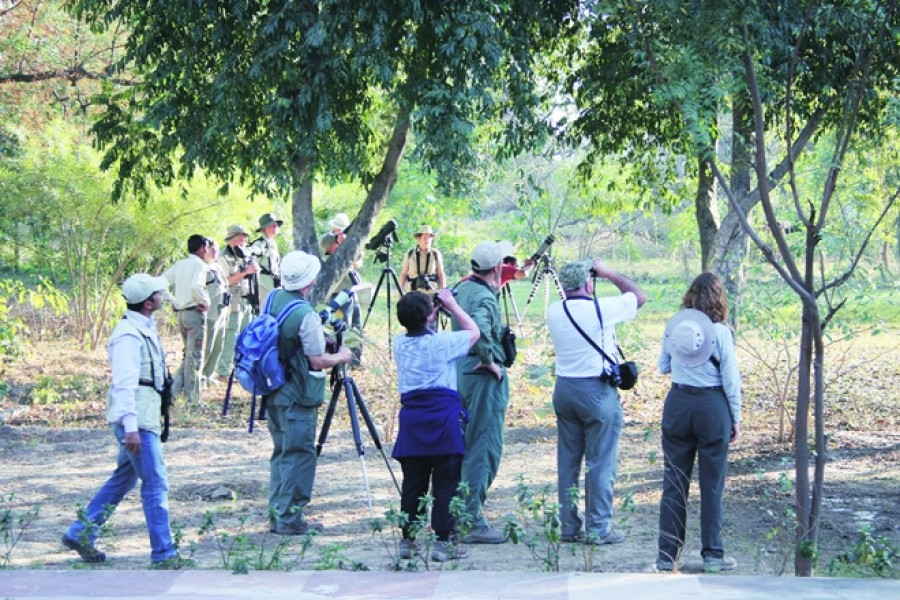
Published :
Updated :

The tourism sector holds enormous potential for gearing up the country's GDP growth. The government has already formulated a National Tourism Policy, the main objective of which is to attract investments from local and foreign entrepreneurs in the sector. But the potential of this sector could not yet be fully harnessed for various reasons. Previously tourism was mainly focused on sea beaches and hilly resorts as well as recreational facilities. Of late, ecotourism has emerged as a favourite outing. This new trend of travelling in groups to nature and enjoying the scenic spots, forests, trees, plants and animals is a recent phenomenon for Bangladesh.
Efforts are underway to boost its growth as well as contribution to GDP through private and public sector initiatives. One such initiative was the project 'Bio-diversity conservation and ecotourism development in Bangladesh'. Implemented during 2011-16, it left a positive impact on ecotourism in the country.
An evaluation by the Implementation, Monitoring and Evaluation Division (IMED) of the government shows an overall positive outcome from the ecotourism project. Previously, only 45.6 per cent of the tourists used to visit forests for spending time with nature. Now that percentage has climbed to 87.9 per cent. Around 14 persons on an average previously visited ecotourism sites per day. That number has now gone up to 110 persons per day, which is eight times higher than the earlier number. The project was taken up to popularise ecotourism in the country and that goal has been achieved to a large extent. A total of 35 forest ranges in 20 districts were covered by the project. The districts were: Lalmonirhat, Rangpur, Dinajpur, Sherpur, Mymensingh, Sirajganj, Tangail, Gazipur, Dhaka, Sylhet, Habiganj, Moulvibazar, Madaripur, Jashore, Khulna, Satkhira, Barguna, Noakhali, Chattogram and Cox's Bazaar.
The IMED evaluation says that the concept of ecotourism has gained acceptance due to the implementation of the project. The number of visitors to eco-parks has increased and the revenue of forest department has also risen. The positive features include extended control over its cottages, rest houses, picnic spots etc. by the forest department. Due to forestation in the designated areas, the trees and plants in the forests have increased. The number of monkeys and deer has risen. Economic activities have also flourished in the project areas. Local people are getting an opportunity of providing different services like transportation, guide service, sale of food items and other commodities on a commercial basis. The conflicts between wild animals and people living in human habitats could also be minimised. Preventive measures like lighting lamps for preventing attacks by wild elephants have been taken. Nearby archaeological and historical sites have also been showcased for attracting additional tourists to the ecotourism sites. Opportunities have been created for income generation of local people, educational and study tours as well as construction of infrastructure facilities.
If ecotourism means "Responsible travel to natural areas that conserves the environment and improves the welfare of local people", Bangladesh has a long way to go. Informed consent and participation of local communities in the management of ecotourism enterprises results in sharing of socioeconomic benefits. It minimises the environmental impact of tourism and showcases the local culture, flora and fauna as main attractions.
Ecotourism represents a significant proportion of national income in many countries of the world including Nepal, Maldives, Costa Rica, Brazil, Ecuador, Kenya, Mauritius and Madagascar. The other genres of tourism related to ecotourism include: adventure travel; sustainable tourism; responsible tourism; nature-based tourism; green tourism; multi-sport adventures and cultural tourism. Adventure travel incorporates the concept of risk-taking and often uses unconventional means of transport. A canoe journey deep into the Amazon basin or a boat journey in a river of Bandarban hill district represents this type of tourism. Sustainable tourism is a form of tourism that does not decrease the availability of resources and allows future travellers to enjoy the same experience. Responsible tourism, on the other hand, operates in a way so as to minimise the negative impacts on the environment. A camping trip in the wilderness by leaving no trace falls in this category. Nature-based tourism caters to any activity or travel experience that focuses on nature. Examples include large lodges in the jungle and travelling by cruise ships to view penguins. Sometimes used interchangeably with ecotourism and sustainable tourism, green tourism is any activity or facility that operates in an environment-friendly fashion. Multi-sport adventures focus on outdoor physical activities like rafting, mountain biking, climbing, diving, surfing etc. Cultural tourism entails interacting with and observing different cultures during travels.
As a follow-up to the completed ecotourism project, more initiatives should be taken by the government here to develop ecotourism, specially in the environmentally and culturally rich areas. The Chattogram Hill Tracts and the Sylhet region are akin to paradises for ecotourism. The world's largest mangrove forest - the Sundarbans in Khulna division, on the other hand, is an ecotourism goldmine. World-class cruise vessels may be pressed into service for carrying tourists to this forest. At the same time, precautions should be taken not to upset the ecosystem of the forest. Ecotourism can also flourish in the Saint Martin's island in the Bay of Bengal, which will also help protect the island. Sound policies are needed for this. These include marketing campaigns, control of visitors' numbers, enforcement of guidelines on tourist movements, as well as waste management facilities. Security and safety of tourists should be given top priority. Deployment of mere tourist police will not solve the security problem and the local people also need to be involved in the process. When local communities derive concrete benefits from ecotourism, they would spontaneously protect and safeguard tourists and tourism sites.


 For all latest news, follow The Financial Express Google News channel.
For all latest news, follow The Financial Express Google News channel.